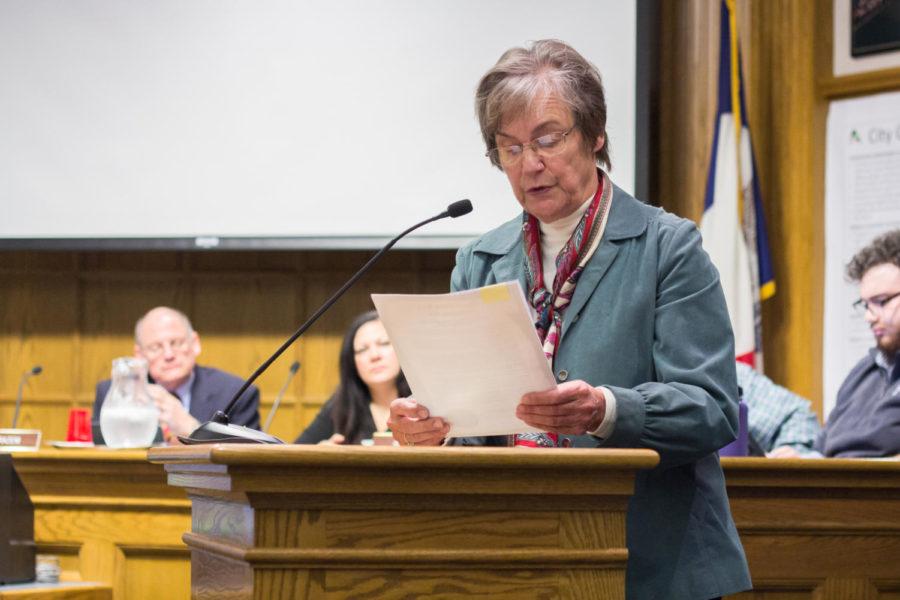- App Content
- App Content / News
- News / Politics And Administration
- News / Politics And Administration / City
Council Discusses Tax Breaks for Greek Houses; Climate Change Goals
Mayor Ann Campbell starts off the City Counsel Meeting Nov. 14. The majority of the meeting was spent Clarifying regarding the city council’s direction pertaining to limiting occupancy in rental units.
November 28, 2017
Ames City Council considered granting a tax abatement to two recently constructed Greek houses at its meeting Tuesday night.
In 2006 the city created the Urban Revitalization Area for the East University Impacted Area, east of Campustown and south of Lincoln Way. The plan was implemented to support “adaptive reuse” of Greek houses in the area, and the city offered a property tax abatement to Greek houses that made improvements that raised the valuations of their buildings by 5 percent.
Buildings eligible for the abatement must be an existing or former Greek residence recognized by Iowa State, and 70 percent of existing walls must remain.
In 2011, the Sigma Chi fraternity asked permission to demolish their house and construct a new one, and for the city to add an amendment for them to receive the tax abatement, even though they were removing more than the allotted 30 percent of existing exterior walls.
The council allowed the demolition, and directed city staff to amend the criteria to allow abatements for new constructions. No follow-up was made on behalf of the city, and no amendment was adopted.
In 2014, Delta Tau Delta, also sought to demolish their current house to construct a new one. City Council did allow the demolition, but did not grant Delta Tau Delta’s request to amend the plan to receive a tax abatement.
Now, Justin Dodge, representing the Greek Alumni Association is asking for a tax abatement for these two newly constructed Greek houses. The new buildings have raised the value of the property by over 5 percent, however since they are new buildings they do not yet qualify for the abatement since they do not have 70 percent of existing exterior walls.
Councilwoman Gloria Betcher spoke out against amending the plan to provide an abatement on the grounds of sustainability. She claimed that by demolishing houses, rather than redeveloping, they are adding unnecessary waste to landfills, and undermining the historical integrity of the area.
“Demolition is not a sustainable way of addressing improvements,” Betcher said.
Councilwoman Bronwyn Beatty-Hansen also spoke out against the proposed amendment, asking if new construction, rather than redevelopment, is worthy of a tax abatement.
Mayor Ann Campbell felt the new buildings were an improvement over what was there previously.
“We have a much better product [Greek houses], we have much better housing of students,” Campbell said.
A movement was made to direct city staff to create an amendment to allow tax abatements per the Urban Revitalization plan for new constructions in a vote of 4-2. The amendment or report from city staff will be brought up again in a future council meeting.
Council passed a resolution to rezone the old Crawford Elementary School at 415 Stanton Ave. to allow for the construction of an independent senior living facility. After hearing overwhelming support from developers and neighborhood residents, the council unanimously voted for the resolution.
Campbell also addressed residency occupancy concerns, saying no related ordinance would be on the agenda tonight, but she expected one to be available for a first reading next week.
Mayor Campbell also addressed the student petition sent out by IRHA in regards to housing occupancy limits. She described the document as having a “good deal of misinformation” in it. She also shared that she has met with university officials for “damage control” related to the petition.
The council also debated how to move forward on measures to reduce Ames’ carbon footprint. In 2007 the city adopted a resolution endorsing the 2005 U.S. Mayors Climate Protection Agreement, and adopting a set of goals and procedures in spirit of the agreement.
This resolution included a goal to reduce the carbon footprint of city operations by 15 percent from its 2001 to 2006 levels by 2014. To go about this, the city split efforts into buildings, vehicles (Cyride and non-Cyride), and miscellaneous.
In terms of city buildings, the city saw an over 17.9 percent reduction in carbon emissions. Non-Cyride vehicles saw a 5.2 percent emission increase 20.3 percent and Cyride saw a 33.6 percent increase. However, the non-Cyride fleet was 20.3 percent more efficient, and Cyride saw a 18.3 percent decrease in CO2 per rider.
Due to growth of the city and increasing amounts of light fixtures, carbon emissions increased 10.6 percent in the miscellaneous category, though the addition of LED bulbs helped keep this number lower.
The city has also, since 2007, been working on community sustainability efforts.
Moving forward the city was debating whether to sign on to the 2014 U.S. Mayors Climate Protection Agreement, a recent agreement made to advocate cities to take action against climate change. They also debated whether or not to set new goals in spirit of the recent climate agreement.
Councilman Tim Gartin brought up partnering with Iowa State’s Initiative for a Carbon Negative Economy. ICNE is a group on campus that is currently advocating for and researching activities that remove carbon from the environment
“We can’t cut carbon fast enough to make a difference,” Gartin said.
Gartin added he was in support of the 2014 mayor’s initiative, but felt reducing emissions would not have a great enough effect. He felt that in order for actual change to occur, the city must look into measures that reduce carbon in the atmosphere citing recent research.
The council passed a motion to reach out to the group and look into providing funds for research into carbon reduction.
















